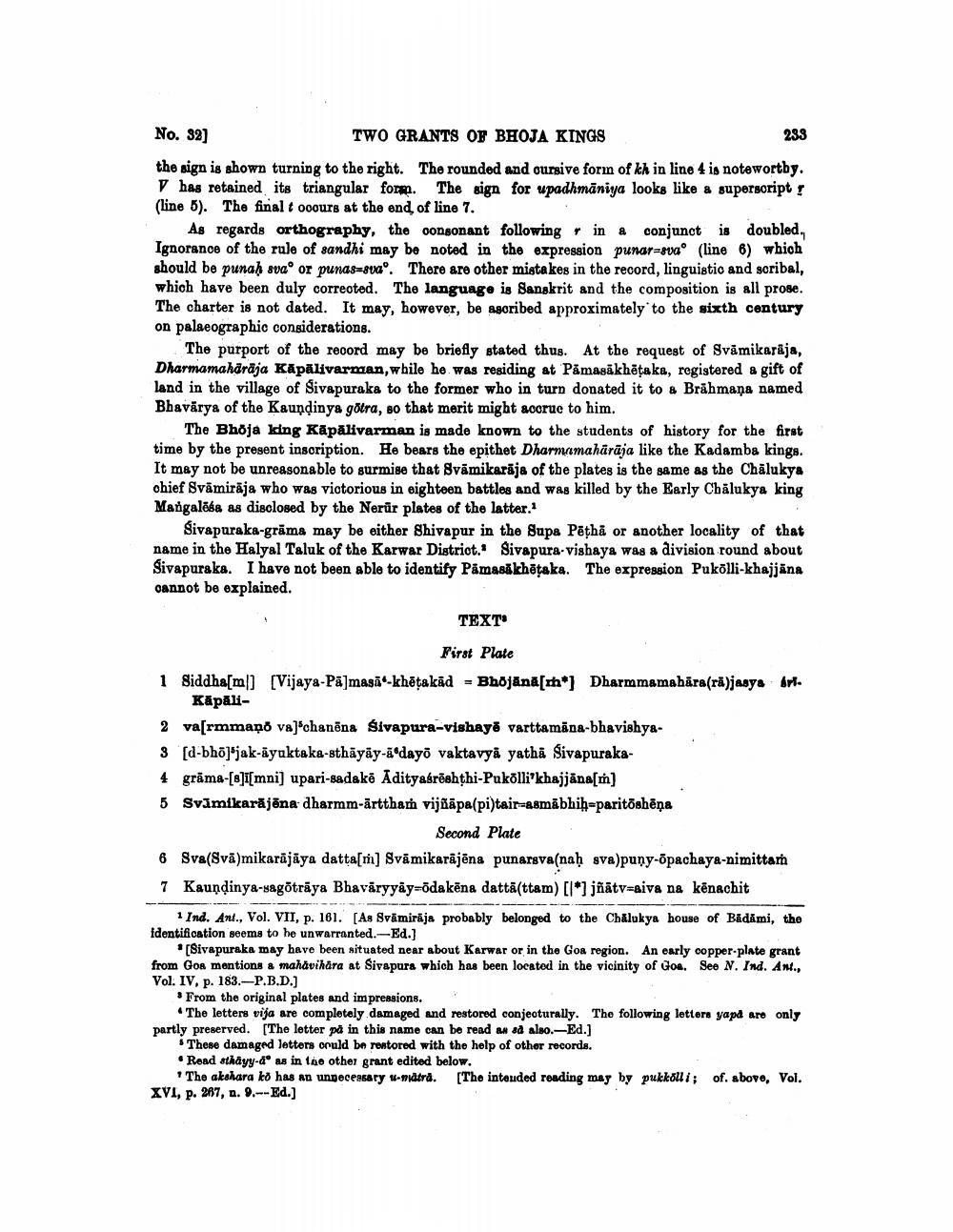________________
No. 32]
TWO GRANTS OF BHOJA KINGS
the sign is shown turning to the right. The rounded and cursive form of kh in line 4 is noteworthy. has retained its triangular form. The sign for upadhmaniya looks like a superscript r (line 5). The final t occurs at the end of line 7.
As regards orthography, the consonant following in a conjunct is doubled, Ignorance of the rule of sandhi may be noted in the expression punar-sva (line 6) which should be punah sva or punas-sva". There are other mistakes in the record, linguistic and scribal, which have been duly corrected. The language is Sanskrit and the composition is all prose. The charter is not dated. It may, however, be ascribed approximately to the sixth century on palaeographic considerations.
233
The purport of the record may be briefly stated thus. At the request of Svāmikarāja, Dharmamahārāja Käpälivarman, while he was residing at Pāmasākhēṭaka, registered a gift of land in the village of Sivapuraka to the former who in turn donated it to a Brahmana named Bhavarya of the Kaunḍinya gotra, so that merit might accrue to him.
The Bhoja king Kāpālivarman is made known to the students of history for the first time by the present inscription. He bears the epithet Dharmamahārāja like the Kadamba kings. It may not be unreasonable to surmise that Svamikaraja of the plates is the same as the Chalukya chief Svāmiraja who was victorious in eighteen battles and was killed by the Early Chalukya king Mangalesa as disclosed by the Nerür plates of the latter.1
Sivapuraka-grāma may be either Shivapur in the Supa Pēṭhā or another locality of that name in the Halyal Taluk of the Karwar District. Sivapura-vishaya was a division round about Sivapuraka. I have not been able to identify Pamasakhēṭaka. The expression Pukōlli-khajjāna cannot be explained.
TEXT
First Plate
1 Siddha[m] [Vijaya-Pa]masi-khōṭakad - Bhōjänä[th] Dharmmamahira(r)jasya il Käpäli
2 va[rmmano va]'chanena Sivapura-vishayē varttamāna-bhavishya
3 [d-bhōjak-ayuktaka-sthāyāy-ä'dayö vaktavya yathā Sivapuraka
4 grāma-[s]i[mni] upari-sadakē Adityaśrēshṭhi-Pukōlli'khajjāna[m]
5 Svāmikarājēna dharmm-arttham vijñāpa(pi)tair-asmābhiḥ=paritōshēņa
Second Plate
6 Sva(Svā)mikarājāya datṭa[m] Svāmikarājēna punarsva (naḥ sva)puny-ōpachaya-nimittam
7 Kaundinya götraya Bhaväryyay-ödakina datti(ttam) [*] jñātv-aiva na kenachit
1 Ind. Ant., Vol. VII, p. 161. [As Svämirāja probably belonged to the Chalukya house of Badami, the identification seems to be unwarranted.-Ed.]
[Sivapuraka may have been situated near about Karwar or in the Goa region. An early copper-plate grant from Gos mentions a mahavihāra at Sivapura which has been located in the vicinity of Goa. See N. Ind. Ant., Vol. IV, p. 183.-P.B.D.]
From the original plates and impressions.
The letters vija are completely damaged and restored conjecturally. The following letters yapd are only partly preserved. [The letter på in this name can be read as så also.-Ed.]
These damaged letters could be restored with the help of other records.
Read sthayy-a" as in the other grant edited below.
The akshara ko has an unnecessary u-mäträ. [The intended reading may by pukkölli; of. above, Vol. XVI, p. 267, n. 9.--Ed.]




